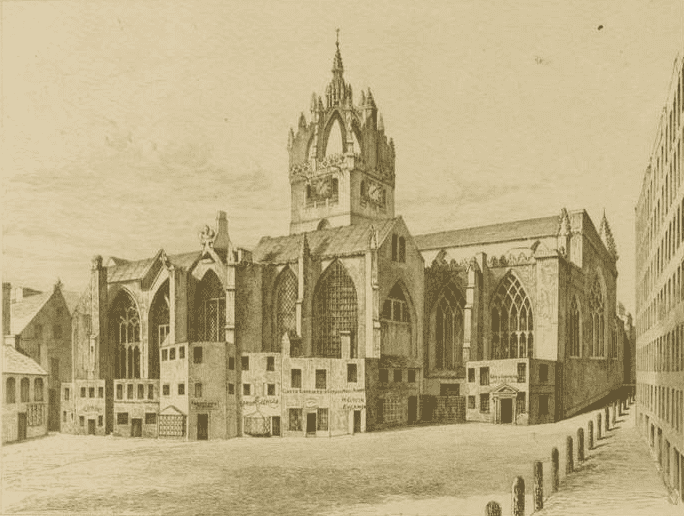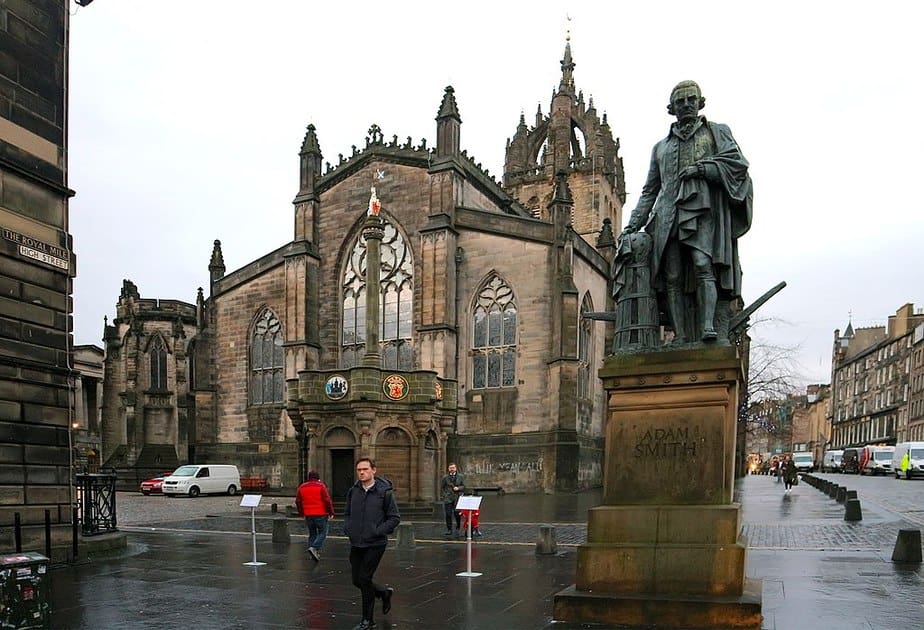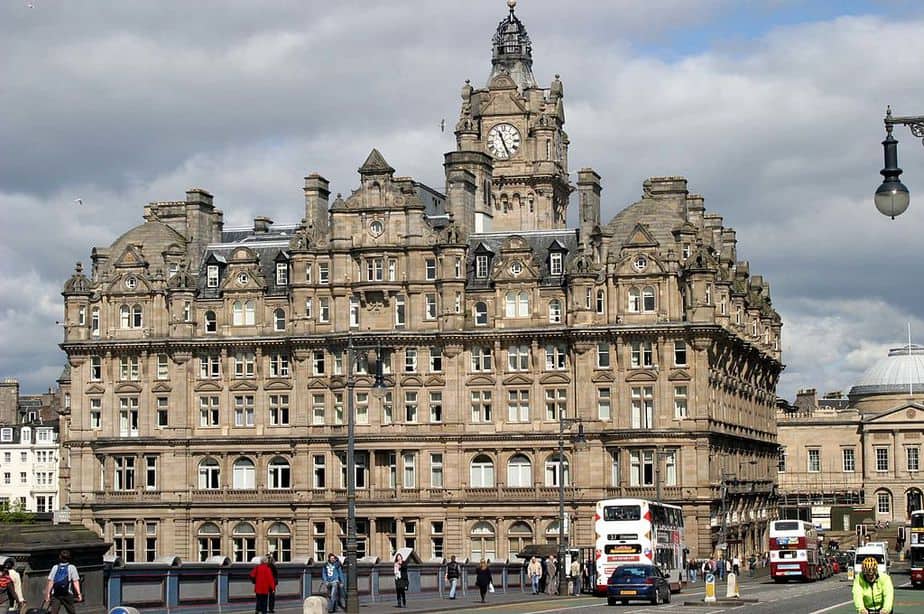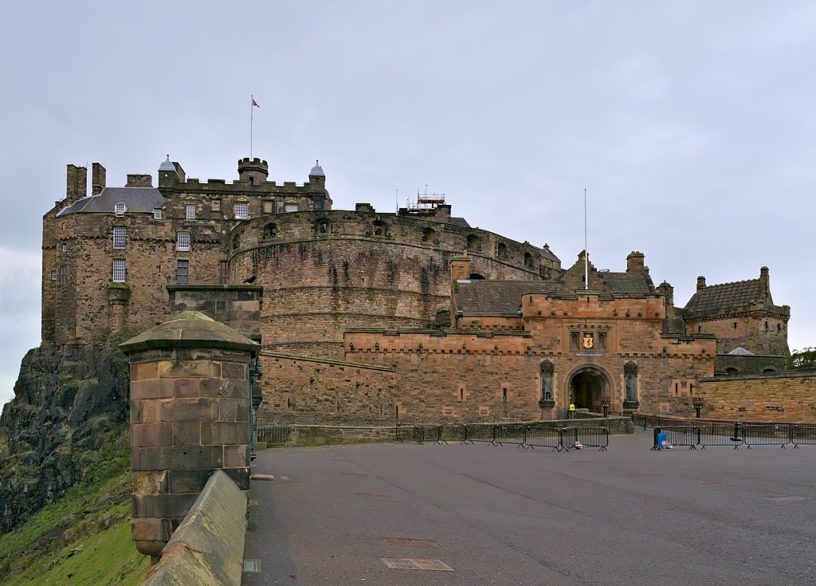10 Best Historical sites to visit in Edinburgh

Edinburgh by William Forrest from Wikimedia Commons
Edinburgh Castle, perched atop an extinct volcano, towers over the city. For centuries, this stone castle has been an integral part of Scotland’s heritage, bearing witness to dramatic occurrences such as Cromwell’s assault in 1650 and Bonnie Prince Charlie’s siege in 1745.
With over a million annual tourists mounting its grounds, its weather-scarred battlements now provide some of the greatest views of the city. It also features St Margaret’s Chapel, Edinburgh’s oldest standing structure, which was built in 1130 by King David I and named for his mother, who was much admired and canonised for her humanitarian services.
1. St Giles’ Cathedral

St Giles by Andraszy from Wikimedia Commons
The Royal Mile, which runs downhill from Edinburgh Castle to the Royal Palace of Holyroodhouse, is the lifeblood of Edinburgh’s Old Town. The Gothic St Giles’ Cathedral, a 900-year-old edifice devoted to the city’s patron saint, sits in the middle. The Thistle Chapel, with its beautiful Neo-Gothic woodwork and gold-leaf roof, is a must-see.
2. Scott Monument

Edinburgh monument by Ermell from Wikimedia Commons
The Scott Monument, affectionately known as the Gothic Rocket by Edinburgh residents, towers majestically above the crowds rushing down Princes Street. It is the world’s second-largest monument devoted to a writer, having been built to memorialize one of Scotland’s greatest authors, Sir Walter Scott, after his death in 1832.
The public can climb the monolith’s narrow spiral staircase for 287 steps to an observation platform at the top for 360-degree views of Edinburgh. While the edifice is dedicated to Scott, it also has 68 statues, including the heads of 16 Scottish poets and writers.
3. The Balmoral Hotel

Balmoral Hotel by W. Bulach from Wikimedia Commons
The Balmoral is a notable landmark on the crossroads of Princes Street and North Bridge, harkening back to the golden age of steam locomotives. Originally established in 1902 as a hotel to service rail travellers arriving at Waverley station, visitors had their luggage delivered directly to their room by porters. The hotel’s clock continues to operate three minutes ahead of schedule so that passengers do not miss their trains, only returning to standard time on New Year’s Eve. The Balmoral is possibly more well-known these days as a result of its Harry Potter ties.
In a room now named after her, author JK Rowling completed the final instalment of her Harry Potter series, Harry Potter and the Deathly Hallows. Guests can reserve the suite, which features a unique brass owl door knocker and a bust signed by the author.
4. National Monument of Scotland
Edinburgh’s Disgrace, Edinburgh’s Folly, and The Pride and Poverty of Scotland, to mention a few, are all nicknames for the National Monument atop Calton Hill. The monument was meant to be Scotland’s homage to the Scottish soldiers and sailors who served and died in the Napoleonic Wars and was sponsored by public subscription.
It was designed by architectural heavyweight William Playfair (who also constructed the National Gallery of Scotland and future extensions to the New Town) and was inspired by the Parthenon in Athens (thus Edinburgh’s flattering moniker of “Athens of the North”). Money to finish it ran out just three years after construction began in 1826, and while there have been various suggested plans to finish it, none have been realized.
5. Scottish Parliament

Scotish parliament by Ermell from Wikimedia Commons
Scotland’s political capital is admittedly not extremely old. In reality, compared to august neighbours like the 17th-century Palace of Holyroodhouse and the National Monument, it is still in its infancy. The Scottish Parliament, which also includes the 17th-century Queensferry House, is a historic landmark in the making since Scotland regained self-government in 1999 as a result of devolution.
The first discussion on the new structure took place in 2004, approximately 300 years after the last Scottish Parliament was dissolved, once it was finished. Enric Miralles, a Spanish architect, drew inspiration from Scotland’s scenery and culture when designing the structure, using Scottish materials such as Kemnay granite and rare Caithness flagstone.
6. Bute House
The Medieval Old Town and the Georgian New Town are the two halves of Edinburgh. Both UNESCO World Heritage sites, the latter was laid out in the 1700s by city planner James Craig, with architect Robert Adam designing many of the city’s most notable structures.
So he did with 6 Charlotte Square, Scotland’s first minister’s official house. Bute House, on the north side of the plaza, stands out due to its grand facade and central front door, which are unique elements not found in the other buildings. The conserved Georgian House in the square also houses a lovely collection of paintings by renowned Scottish artists, including Sir Henry Raeburn.
7. Usher Hall

Usher hall sculpture by Kim Traynor from Wikimedia Commons
The number of live music venues in Edinburgh has diminished in recent years, but the Usher Hall has stood the test of time. It was dedicated to its patron, whiskey producer and blender Andrew Usher, who pledged £100,000 to the city to create a music hall for concerts and recitals after a competition was held in 1910.
Usher Hall is recognized for its exceptional acoustics as well as its unique round walls and dome. The auditorium has hosted classical and modern concerts, political demonstrations, and the 1972 Eurovision Song Contest, as well as boxing at the Commonwealth Games in 1986.
8. Greyfriars Bobby

Greyfriars Bobby by Daniel Kraft from Wikimedia Commons
Greyfriars Bobby proved that dogs truly are a man’s greatest friend in the ultimate tale of canine fidelity. Bobby famously guarded his master’s grave in Greyfriars Kirkyard until his death in 1872. He is buried in the same cemetery as his alleged owner, John Gray. A life-size statue of the little Skye terrier stands near the graveyard gates on Edinburgh’s George IV Bridge (which is also the city’s smallest listed building). The story inspired a wealthy philanthropist, who paid sculptor William Brodie to erect it in 1873.
The monument was originally intended to serve as a watering fountain for both dogs and humans, but it has now become one of the city’s most popular attractions, with tourists frequently touching Bobby’s nose for good luck – however, this is discouraged because it is beginning to fade!
9. The Dean Village
Walking through the cobblestone streets of this village within a city, you’d never guess you were in the heart of Edinburgh. With the cascading Water of Leith flowing through its heart, the Dean Village is something of a green sanctuary. The village, which once housed numerous significant grain mills, is approximately 800 years old, but Well Court is its most notable structure.
It was designed in 1886 as model housing for mill workers and their families and was recently refurbished. Its striking red sandstone features, which include a clock tower and courtyard, are now the focal point of a peaceful retreat for locals. The Dean Bridge and the Neoclassical Scottish National Gallery of Modern Art are both located in this region.
10. Edinburgh Castle

Edinburgh Castle by Daniel Kraft from Wikimedia Commons
Edinburgh Castle, perched atop an extinct volcano, towers over the city. For centuries, this stone castle has been an integral part of Scotland’s heritage, bearing witness to dramatic occurrences such as Cromwell’s assault in 1650 and Bonnie Prince Charlie’s siege in 1745.
With over a million annual tourists mounting its grounds, its weather-scarred battlements now provide some of the greatest views of the city. It also features St Margaret’s Chapel, Edinburgh’s oldest standing structure, which was built in 1130 by King David I and named for his mother, who was much admired and canonised for her humanitarian services.
It’s the breathtaking city that has everything for everyone and is deservedly regarded as one of Europe’s most beautiful attractions. This city offers it all, whether you’re searching for culture, nightlife, rolling hills, or amazing food.
Planning a trip to Paris ? Get ready !
These are Amazon’s best-selling travel products that you may need for coming to Paris.
Bookstore
- The best travel book : Rick Steves – Paris 2023 – Learn more here
- Fodor’s Paris 2024 – Learn more here
Travel Gear
- Venture Pal Lightweight Backpack – Learn more here
- Samsonite Winfield 2 28″ Luggage – Learn more here
- Swig Savvy’s Stainless Steel Insulated Water Bottle – Learn more here
Check Amazon’s best-seller list for the most popular travel accessories. We sometimes read this list just to find out what new travel products people are buying.










